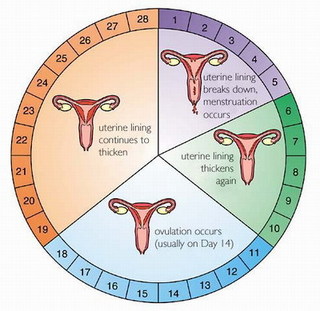I blogged previously about the challenges that women with type 1 diabetes face, now here is another - MENSTRUATION. Menstruation occurs at puberty and describes the physical and emotional changes that a girl or boy go through making them adults and capable of reproducing (having children).

Source: http://www.wakeuppune.org/site/index.php/sex-education/puberty
In some women who have type 1 diabetes, the hormonal changes that come with menstruation can cause changes in blood glucose levels. Monitoring levels and adjusting insulin accordingly is key to managing this monthly shift (Krisha McCoy, MS).
In a study of Menstrual Cycle Differences Between Women With Type 1 Diabetes and Women Without Diabetes (http://care.diabetesjournals.org/content/26/4/1016.full) the following differences were reported:
Table 2—
Self-reported menstrual cycle characteristics of women with and without type 1 diabetes by age range
| Type 1 diabetes | Without diabetes | P | |||
|---|---|---|---|---|---|
| Sisters | Control subjects | ||||
| <20 years of age (n) | 143 | 186 | 158 | ||
| Bleeding ≥6 days | 56.5 | 41.6 | 47.7 | 0.04 | |
| Cycles >31 days | 24.8 | 14.3 | 17.8 | 0.07 | |
| Heavy bleeding | 25.2 | 18.1 | 22.4 | 0.31 | |
| Any irregularity | 78.7 | 64.3 | 66.7 | 0.02 | |
| 20–29 years of age (n) | 143 | 186 | 158 | ||
| Bleeding ≥6 days | 52.8 | 38.7 | 40.5 | 0.04 | |
| Cycles >31 days | 22.1 | 8.0 | 12.3 | 0.002 | |
| Heavy bleeding | 27.0 | 14.7 | 21.0 | 0.03 | |
| Any irregularity | 76.8 | 55.4 | 55.5 | <0.001 | |
| 30–39 years of age (n) | 141 | 180 | 152 | ||
| Bleeding ≥6 days | 44.8 | 41.1 | 36.2 | 0.36 | |
| Cycles >31 days | 11.9 | 8.4 | 8.3 | 0.53 | |
| Heavy bleeding | 25.0 | 18.6 | 25.2 | 0.29 | |
| Any irregularity | 67.5 | 57.9 | 53.8 | 0.08 | |
| 40–49 years of age (n) | 100 | 114 | 91 | ||
| Bleeding ≥6 days | 40.8 | 36.0 | 29.0 | 0.34 | |
| Cycles >31 days | 8.6 | 11.1 | 10.4 | 0.87 | |
| Heavy bleeding | 21.6 | 27.5 | 29.2 | 0.55 | |
| Any irregularity | 67.6 | 67.4 | 62.1 | 0.74 | |
- Data are %.
According to the results of the study 'women with type 1 diabetes had more menstrual problems (long cycles, long menstruation, and heavy menstruation) before age 30 years than sisters and control subjects. These differences were all statistically significant, except for heavy menstruation at age <20 years. No differences were observed after age 30 years. Women with type 1 diabetes experienced later menarche, earlier natural menopause, fewer pregnancies, and more stillbirths than women without diabetes. Multiple regression analyses revealed that type 1 diabetes caused an approximate twofold increased risk of any menstrual problem before age 30 years. These were primarily related to long cycles and long menstruation in women aged <20 and 20–29 years, as well as with heavy menstruation from 20 to 29 years. Oral contraceptives were protective for any menstrual problem and heavy menstruation from 30 to 39 years of age. With history of pregnancy from 20 to 40 years of age, any menstrual problem and long menstruation were more likely' (Elsa S. Strotmeyer, PHD, Ann R. Steenkiste, MS, Thomas P. Foley, Jr, MD, Sarah L. Berga, MD and Janice S. Dorman, PHD).
According to Jay Cohen, MD (medical director of the Endocrine Clinic in Memphis and clinical assistant professor in the department of family medicine at the University of Tennessee), "Two or three days before menstruation, as estrogen and progesterone levels are changing, a number of women — but not all — will notice that their insulin needs increase substantially because their blood glucose levels are rising,” In addition he adds that, "In women whose diabetes is out of control, high blood sugars can put a woman at increased risk of vaginal and yeast infections, and can also affect regular menses," says Cohen. "Once again, it is important to have good blood sugar control on a regular basis.”
So ultimately it all still boils down to the same thing: TEST, TEST and TEST and then use the test results to make the necessary changes to your insulin requirements. Also speak to your endo or gynae if you have any concerns.
No comments:
Post a Comment